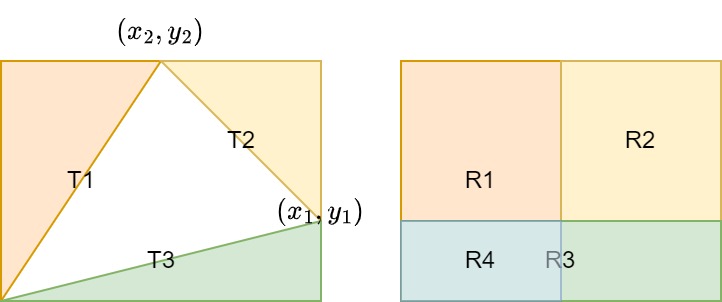Isoperimetric Inequality
Area of a Simple Closed Curve
Let \(\gamma: (0,L) \rightarrow \mathbb R^2, \gamma(s) = (x(s), y(s))\) be a simple closed unit-speed curve, \(\text{int}(\gamma)\) be the bounded interior. Then the area of \(\gamma\) is defined as
By Green's Theorem, we can instead integrating through the boundary, i.e.
Applied on the area integral, by taking \(f(x,y)= \frac{-y}{2}, g(x,y) = \frac{x}{2}\)
Also, if we take \(f(x, y) = -y, g(x,y)=0\) or \(f(x,y) = 0, g(x,y)=x\), then
Geometric Interpratations
Lemma Consider a triangle \(A = (0, 0), B = (x_1,y_1), C = (x_2, y_2)\), WLOG assume \(x_1>x_2, y_1<y_2\). Then, its area is
proof.
Claim For a polygon of \(n \geq 3\) points \(P_k = (x_k, y_k), k = 1,2,...,n\), its area is
proof. Let \(n = 3\), translating the polygon by \(-(x_1, y_1)\) and use the equation above.
Let \(n > 3\), then note that the polygon can be divided into a polygon \(P_1,...,P_{n-1}\) and a triangle \(P_{n-1}, P_{n}, P_1\). Therefore,
Therefore, for a curve \(\gamma\), take each \(P_{k} = \gamma(s_k), P_{k+1} = \gamma(s_k + \Delta s) = (x_k + dx, y_k + dy)\),
Isoperimetric Inequality (E. Schmidt)
Claim For a simple closed curve \(\gamma(s) = (x(s), y(s))\) with length \(L\) and area \(A\). Then \(A\leq \frac{L^2}{4\pi}\). Moreover, \(A = \frac{L^2}{4\pi}\) IFF \(\gamma\) is a circle.
proof. Since \(\gamma\) is a simple closed curve, Take \(x_0 = \min(x(s)), x_1 = \max(x(s)), w= x_1-x_0\), take \(R = \frac{w}{2}\).
Let \(C\) be a circle of radius \(R\) centered at \((0, 0)\). WLOG, translate \(\gamma\) by \((-\frac{x_0+x_1}{2}, 0)\) so that \(x_0=-R, x_1=R\).
Parameterized \(C\) by projecting \(\gamma\) to the circle. i.e. \(c(s) = \text{proj}(x(s), y(s)) = (x(s), \hat y(s))\) where \(x(s)^2 + \hat y(s)^2 = R^2\). Note that \(c\) is not regular.
For each \(s\), look at its projection to the outer unit normal \(-\mathbf n_s(s) = (y'(s), -x'(s))\) (rotating tangent clockwise by \(\pi/2\)). Take \(\text{proj}_c\) to be the projection from \(c(s)\) to \(-\mathbf n_s(s)\),
where \(a\) is the angle between \((x,\hat y), (y',-x')\) Note that \(\text{proj}_c(s) = R\iff \alpha(s) = 0\) IFF the outer normal is directed exactly the same as the vector on the circle.
Also, we have the inequality
and integrating along the curve
Then, consider the conditions for the equality. First, we must have \(L = 2\pi R\) from the computations above, and this must be try for each direction. Also, we must have that for all \(s, \alpha = 0 \iff (x,\hat y) \perp (x',y')\).
Isoperimetric Inequality (Steiner)
Fact 1 \(A\leq \pi L^2\), i.e. the curve can be contained within a circle of radius \(L\)
Fact 2 \(\gamma\) is convex.
Suppose that the line segment \(\gamma(s_0), \gamma(s_1)\) is not contained in \(\text{int}(\gamma)\), then flip \(\gamma([s_0, s_1])\) around the line segment and we can get a larger area with the same arc length.
Fact 3 If \(\gamma\) is convex, then \(\kappa_s(s)\) does not change its sign for all \(s\).
Fact 4 For any point \(P\) on a circle \(C\), and a diameter \(AB\), for the triangle formed by \(P, A, B\), the angle at \(P, \theta_P = \pi/2\).
Claim If for any simple closed plane curve of length \(L\), exists some curve \(\gamma\) that attains the maximum, then \(\gamma\) is a circle of \(R = \frac{L}{2\pi}\).
Note that the assumption (existence of maximum won't not proved here)
proof. Take some convex \(\gamma\) be the curve that attains maximum area, take \(a,b\) s.t. each \(\gamma([a, b)) = \gamma([b, a)) = L/2\). Then, \(\text{int}(\gamma)\) is divided into two parts, call then \(D_1, D_2\) with area \(A_1, A_2\). Then, we must have that \(A_1 = A_2\), otherwise we can find a curve with larger area by flipping the larger half. Therefore, we have that for all \(P_1, P_2\) that divides the arc into 2 equal pieces, the divided areas must be equal.
Then, we want to show that \(D_1\) and \(D_2\) are both semicircles with diameter \(P_1P_2\), by Fact 4, equivalently we want to show that \(\theta_p = \pi/2\) for any \(P\) on the curve.
Suppose \(D_1\) is not a semicircle, then take some \(P\) s.t. \(\theta_P\neq \pi/2\).
Then, consider the domain enclosed by the line segment and curve between \(PP_1\) and the line segment and curve between \(PP_2\). We can rotate the two domains around \(P\) so that \(\theta_P = \pi/2\). Note that the area of the triangle formed by \(PP_1P_2\) has its maximum when \(\theta_P=\pi/2\), the area of other 2 domains does not change, the arc length does not change. Therefore, by contradiction, we proved that \(\theta_P = \pi/2\) for all \(P\).
Example: Isoperimetric Inequality on Ellipse
Claim. Let the ellipse be defined as \(\frac{x^2}{p^2} + \frac{y^2}{q^2} =1\). Then, we have that
with equality IFF \(p=q\).
proof. Let \(\gamma(t) = (p\cos t, q\sin t)\) be the parameterization of the ellipse. so that \(\gamma'(t) = (-p\sin t, q\cos t)\). and the arc-length
and the area of the ellipse is
By Isoperimetric Inequality,
\(p=q\) IFF the ellipse is a circle IFF Isoperimetric equality holds.
